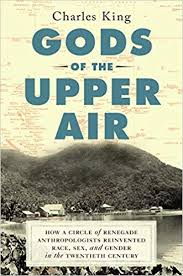Charles King
Doubleday

|
If you really wanted to understand what was happening in a Kwakiutl village or an Inuit camp, you had to try as hard as possible to divest yourself of the opinions common to the environment in which you were born. You had to struggle to follow new trains of thought and new logic, to grab on to new emotions…Otherwise you couldn’t claim to understand anything at all. You were simply staring at your own biases, reflected back at you in the mirror of someone else’s culture. from Gods of the Upper Air |
A better idea
Once upon a time the earth was flat. The earth was also the center of the universe, which is why the sun and planets revolved around it. We had this on good authority.
Throughout history, humans have been telling stories to explain the world. The stories changed as our understanding changed, T.H. Huxley noting, “It is the customary fate of new truths to begin as heresies and to end as superstitions.” Turns out, the earth wasn’t flat after all.
In Gods of the Upper Air, Georgetown University professor Charles King offers a fascinating account of the stories the West has told itself to understand race and gender, and how Franz Boas (1858-1942) and his students challenged and found those theories “not supported by the evidence,” i.e., wrong.
In the nineteenth century, there was an idea popular in Europe and the U.S. that humanity was divided into different races and that there was a racial hierarchy. By an interesting coincidence, they discovered that their own “white” race was superior to all others. Boas challenged what has come to be recognized as cultural bias, arguing that the idea of race was a social concept, not a biological reality. He understood other factors to account for cultural differences (See, for example, Jared Diamond’s excellent Guns, Germs and Steel.)
As a young man, Boas became fascinated by the Inuit on Baffin Island, and then the Tlingit and Kwakiutl of the Pacific Northwest. Studying these alien cultures, he realized they had their own worldviews, with their own logic and social rules. Appointed a professor at Columbia University in 1897, he set out to challenge the common theories of the day with evidence from his and other’s field studies, asserting that “civilization is not something absolute, but that it is relative, and that our ideas and conceptions are true only so far as our civilization goes.”
His revolutionary ideas were taken up by his students, who became major figures in the field of cultural anthropology: Margaret Mead (Coming of Age in Samoa,) Ruth Benedict (Patterns of Culture, The Chrysanthemum and the Sword), Zora Neale Hurston, whose studies of the African American culture of the deep South spawned her classic novel, Their Eyes Were Watching God; and Ella Cara Deloria, working to record the rapidly vanishing traditions of the Plains Indians. (Boas remarked to a colleague, “All my best students are women.”) Rather than finding one culture “superior” (superior by whose standards?), they asserted that all cultures are, in Mead’s words, “experiments in what could be done with human nature.”
King’s book is particularly relevant today because we are still working from largely outdated concepts about race and gender. As Hurston wrote to Mead, “Facts go down mighty hard with some folks.” To this day there are people who believe the earth is flat.
This review first appeared in The Columbia River Reader (September 15-October 15, 2019.) Reprinted with permission.



